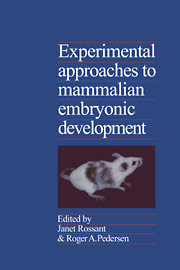Book contents
- Frontmatter
- Contents
- Preface
- Contributors
- Cellular aspects
- 1 Potency, lineage, and allocation in preimplantation mouse embryos
- 2 Time and space in the mouse early embryo: a cell biological approach to cell diversification
- 3 Comparative aspects of embryo manipulation in mammals
- 4 Development of extraembryonic cell lineages in the mouse embryo
- 5 Analysis of tissue fate and prospective potency in the egg cylinder
- Molecular and biochemical aspects
- Toward a genetic understanding of development
- Index
5 - Analysis of tissue fate and prospective potency in the egg cylinder
from Cellular aspects
Published online by Cambridge University Press: 31 March 2010
- Frontmatter
- Contents
- Preface
- Contributors
- Cellular aspects
- 1 Potency, lineage, and allocation in preimplantation mouse embryos
- 2 Time and space in the mouse early embryo: a cell biological approach to cell diversification
- 3 Comparative aspects of embryo manipulation in mammals
- 4 Development of extraembryonic cell lineages in the mouse embryo
- 5 Analysis of tissue fate and prospective potency in the egg cylinder
- Molecular and biochemical aspects
- Toward a genetic understanding of development
- Index
Summary
Introduction
The construction of fate maps and the assessment of cell or tissue potency have preoccupied developmental biologists since the inception of experimental embryology. However, despite its nineteenth-century origins, the question of the relationship among cell ancestry, cell location, and cell commitment is not outdated. It remains a central issue in contemporary embryology.
Fate maps depict what cells in particular locations will give rise to in the undisturbed embryo. That is, they provide an indispensable description of the regular and predictable deployment of cells to different tissues. Prospective potency, on the other hand, constitutes an inventory of the variety of tissues that cells are capable of forming under different circumstances at a given time. Evidence from a number of organisms indicates that there is a progressive and heritable restriction in the prospective potency of cells during development. Thus, comparisons between prospective fate and potency can produce a more sophisticated picture of embryogenesis that charts the divergence of cell or tissue lineages into different, and usually mutually exclusive, developmental pathways. An appreciation of when and where the progenitors of a particular tissue or pattern element originate is obviously a prerequisite for any causal explanation of their segregation. This has been exemplified by the recent investigations of gene expression related to segmentation and segment identity in Drosophila. Here, prior knowledge of segment lineage provided an immediate and necessary context for the molecular findings (Gehring 1985).
- Type
- Chapter
- Information
- Experimental Approaches to Mammalian Embryonic Development , pp. 121 - 148Publisher: Cambridge University PressPrint publication year: 1987



